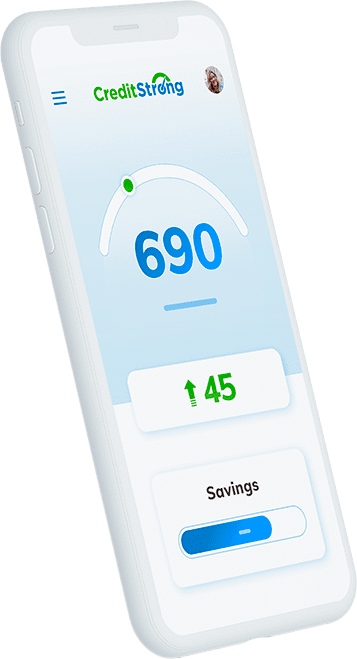The Minimum Credit Score for a VA Loan

Build strong credit
while you save

The Department of Veterans Affairs (VA) offers many benefits to military service members. Prominent among them is the VA home loan, which is one of the ways the department promotes homeownership among veterans and their families.
VA loans have advantages over other mortgage types, including a 0% down payment loan option with no mortgage insurance premium. However, qualifying members still need to meet specific credit requirements to get approval from a VA loan officer.
Here’s what you should know about the minimum credit score for a VA loan.
What is the Minimum Credit Score Requirement for a VA Loan?
The VA loan program doesn’t outline a minimum credit score necessary to qualify for a VA home loan. It only asks that you apply for a certificate that confirms you meet the minimum military service history requirements for VA loan eligibility.
However, the department isn’t the only party that gets a say on whether a borrower qualifies for a VA home loan because it doesn’t provide the financing for any loans. Rather, it insures them for select mortgage lenders.
Each VA-approved lender is free to set their own VA loan requirements. That often includes a minimum credit score. Usually, you can expect a VA lender to ask for a minimum score between 580 and 660.
FICO scores range from 300 to 850, so 580 is pretty attainable. For perspective, the average score among consumers with a mortgage was 753 in 2020.
Lenders are more willing to give a VA mortgage loan to someone with a lower credit score because the loans are insured. When VA borrowers default, the VA reimburses their private lenders for a significant portion of their mortgage balances.
How Does Having a Good Credit Score Affect the Rates and Terms of a VA Loan?
While it’s possible to qualify for a VA loan with a FICO score as low as 580, raising your credit score can only benefit you.
Not only does it increase your chances of approval for higher loan amounts, but it can significantly lower your interest rate. That can save you thousands of dollars over the loan term and drastically reduce your monthly payment.
For example, if you have a 620 credit score, you should expect a mortgage interest rate of roughly 7.833%. On a $300,000 loan, that equates to a $2,166 monthly payment and $479,929 in interest over 30 years.
However, if you could raise your credit score 100 points, you’d reduce your interest rate, monthly payment, and total interest to 6.466%, $1,890, and $380,220, respectively, saving you almost $100,000 in interest expense.
One of the best ways to raise your credit score is with a credit builder loan like Credit Strong’s. You can qualify for one of our accounts with bad credit or zero credit history since we don’t check your score when you apply.
We report to each major credit bureau, so if you make your payments on time, you can see rapid results. The average account holder increases their FICO Score 8 by more than 25 points within just three months of opening their account.
Within nine months, the average increase is almost 40 points. After a year? Nearly 70 points. As you’ve seen, that can make a world of difference in the interest rate you get from your mortgage lender.
You can cancel at any time without penalty, so give it a try today!
How Does a Previous Bankruptcy or Foreclosure on Your Credit Report Affect Your Chances of Getting a VA Loan?
Bankruptcy and foreclosures both cause significant damage to your credit score and make getting a mortgage impossible for at least a few years. However, having one or the other on your credit report doesn’t mean you can’t ever get a VA loan.
In fact, it’s usually easier to get a VA loan after going through these legal proceedings than it is to get a conventional mortgage, though it’s still likely to be challenging.
The first obstacle is the mandatory waiting period after foreclosures and bankruptcies during which you can’t qualify for mortgages. Here are the minimum waiting periods for VA loans:
- Foreclosures: Two years
- Chapter 7 bankruptcy: Two years after discharge
- Chapter 13 bankruptcy: One year after filing
Notably, the bankruptcy waiting periods are shorter than they are for conventional mortgages. You usually have to wait four years after filing Chapter 7 and two years after the discharge of Chapter 13 to get one.
The second obstacle is the damage bankruptcies and foreclosures do to your credit score. It’s difficult to say exactly how much they cost you since everyone’s circumstances are unique, but you can easily lose 100 to 200 points.
Ultimately, qualifying for a VA loan after a bankruptcy or foreclosure is primarily a matter of time. You need to wait out the mandatory waiting period and stay disciplined for a few years to get your low credit score back up above the minimum threshold.

Alternatives to VA loans
If you qualify for the VA loan benefit, it’s often the best loan type available to you. Down payments are a significant obstacle for most would-be homeowners, and the lack of mortgage insurance is fantastic.
However, there is a downside to VA loans. Namely, the VA funding fee, which is a closing cost all VA loan borrowers incur. It can be as much as 2.3% of the mortgage balance on a VA purchase loan, which can be significant.
As a result, it’s still worth considering the alternatives to VA loans, especially if you can afford a 20% down payment. Fortunately, there are several other competitive options. Here’s what you should know about them.
FHA Loans
The VA isn’t the only agency of the federal government that backs home loans. The Federal Housing Administration (FHA) insures mortgages with approved lenders too, and there are no unusual qualification requirements.
In fact, FHA loans are among the easiest to qualify for since you can get one with a credit score as low as 500, though you’ll have to put a down payment of at least 10%.
If you can’t afford 10% down, you can still get an FHA loan with bad credit. With a score of at least 580, you can qualify for a down payment as low as 3.5%.
Unfortunately, getting an FHA loan with a down payment below 20% means you’ll have to pay a mortgage insurance premium. It’ll increase your closing costs and your monthly payment, but you can refinance into a conventional loan at 20% equity to get out of it.
In addition to the down payment requirements, FHA loans must be for your primary residence, and you’ll need a back-end debt-to-income (DTI) ratio of less than 43%.
Your DTI ratio equals your total monthly debt payments, including your mortgage payment, divided by your monthly gross income.
For example, if you have a $400 car payment and make $6,000 per month, you can’t qualify for an FHA loan that requires a monthly mortgage payment greater than $2,408.
$2,408 plus $400 equals $2,808, which is 43% of $6,000.
Conventional Loans
Conventional loans include any mortgages that don’t have the backing of a federal government agency. They come in two variations:
- Conforming: These conventional loans follow the guidelines of Fannie Mae and Freddie Mac, two government-sponsored enterprises.
If the lenders who originate these loans don’t follow their rules, Fannie Mae and Freddie Mac won’t buy them, and lenders usually prefer to sell their mortgages. - Non-conforming: These loans don’t follow Fannie Mae or Freddie Mac guidelines, so there are no standard down payments, loan amounts, or qualification requirements for them.
Conforming conventional loans have a minimum credit score of 620, though you won’t get the best interest rates at that credit level. You’ll also need to have a DTI ratio no higher than 45%, though some lenders allow 50%.
First-time homebuyers can qualify for a conventional loan with a down payment as low as 3%. Others have to put down 5% or more. They charge private mortgage insurance until you hit 20% equity, but you don’t have to refinance to get rid of it.
USDA Loans
Like the VA and the FHA loans, the United States Department of Agriculture (USDA) also partners with some private lenders and insures their mortgage loans.
USDA loans help people with lower incomes in rural areas become homeowners. Most USDA lenders look for a credit score of at least 640 and have a 41% maximum DTI ratio.
In addition, you’ll need to meet the following requirements:
- Rural area: USDA loans are only available for properties in locations with populations below 35,000.
- Income limit: You must have an income within 115% of the median for your area.
If you meet the requirements, you can get a USDA loan with 0% down. However, unlike with a VA loan, you’ll have to pay mortgage insurance until you can refinance at 20% equity.
CreditStrong helps improve your credit and can positively impact the factors that determine 90% of your FICO score.
